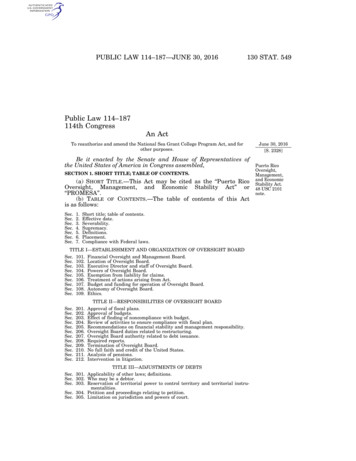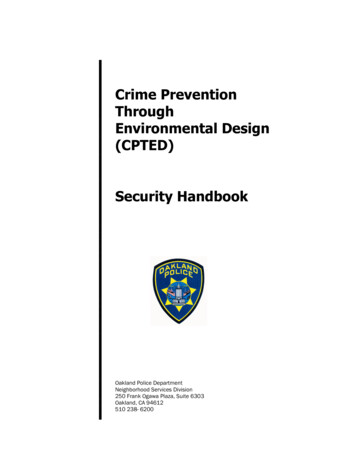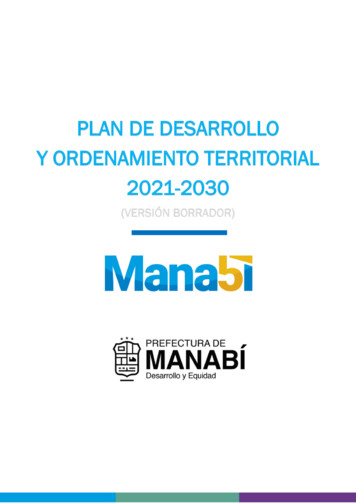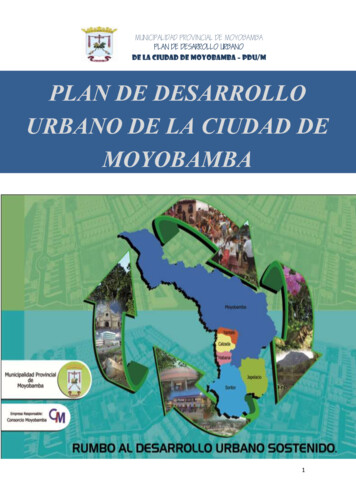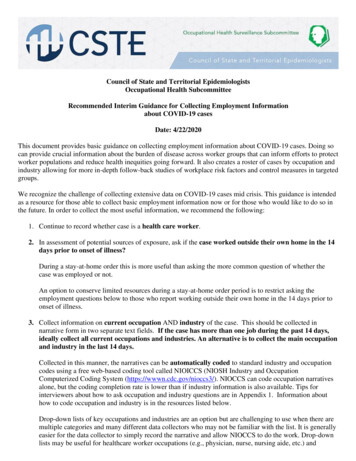
Transcription
Council of State and Territorial EpidemiologistsOccupational Health SubcommitteeRecommended Interim Guidance for Collecting Employment Informationabout COVID-19 casesDate: 4/22/2020This document provides basic guidance on collecting employment information about COVID-19 cases. Doing socan provide crucial information about the burden of disease across worker groups that can inform efforts to protectworker populations and reduce health inequities going forward. It also creates a roster of cases by occupation andindustry allowing for more in-depth follow-back studies of workplace risk factors and control measures in targetedgroups.We recognize the challenge of collecting extensive data on COVID-19 cases mid crisis. This guidance is intendedas a resource for those able to collect basic employment information now or for those who would like to do so inthe future. In order to collect the most useful information, we recommend the following:1. Continue to record whether case is a health care worker.2. In assessment of potential sources of exposure, ask if the case worked outside their own home in the 14days prior to onset of illness?During a stay-at-home order this is more useful than asking the more common question of whether thecase was employed or not.An option to conserve limited resources during a stay-at-home order period is to restrict asking theemployment questions below to those who report working outside their own home in the 14 days prior toonset of illness.3. Collect information on current occupation AND industry of the case. This should be collected innarrative form in two separate text fields. If the case has more than one job during the past 14 days,ideally collect all current occupations and industries. An alternative is to collect the main occupationand industry in the last 14 days.Collected in this manner, the narratives can be automatically coded to standard industry and occupationcodes using a free web-based coding tool called NIOICCS (NIOSH Industry and OccupationComputerized Coding System (https://wwwn.cdc.gov/nioccs3/). NIOCCS can code occupation narrativesalone, but the coding completion rate is lower than if industry information is also available. Tips forinterviewers about how to ask occupation and industry questions are in Appendix 1. Information abouthow to code occupation and industry is in the resources listed below.Drop-down lists of key occupations and industries are an option but are challenging to use when there aremultiple categories and many different data collectors who may not be familiar with the list. It is generallyeasier for the data collector to simply record the narrative and allow NIOCCS to do the work. Drop-downlists may be useful for healthcare worker occupations (e.g., physician, nurse, nursing aide, etc.) and
industries (e.g., hospital, clinic, nursing home, etc.) and other high-risk groups such as law enforcementand firefighters. If a drop-down list is used, always include a write-in option, which can then be codedusing NIOCCS. If you are using a drop-down list and it is performing well for COVID-19 surveillance,continue to use it. If you are interested in developing a drop-down list or have one to share, contact theCSTE Occupational Health subcommittee clingwall@cste.org.4. Collect employer name and location. This information is important for contact tracing and clusteridentification.Note that many employers’ names cannot be readily coded to industry categories such as home care,grocery stores, restaurants, local delivery services, construction, and paper product manufacturing. Theexceptions are licensed health facilities for which health departments have rosters, and larger companies.Coding employer name to an industry is highly labor intensive and more likely to fail to assign a code tosmaller establishment. It is best to collect not only employer name but also industry.5. Include options for “patient contact”, and “co-worker contact” in addition to “household contact” and“community contact” when assessing possible exposures to COVID-19 positive individuals.Resources for collecting and coding occupation and industry information.NIOSH Industry and Occupation Computerized Coding System (NIOCCS) NIOCCS is a free web-based tool used to translate industry and occupation text into standardizedcodes. tml andhttps://wwwn.cdc.gov/nioccs3/Real-Time Coding of Industry and Occupation Data Using a NIOSH-Modified Version of CDC's Epi Info7 Software NIOSH has produced a modified version of CDC’s open-source Epi Info 7 software program thatincludes tools for the real-time coding of industry and occupation data during field data collection. Ifyou are interested in using these tools for COVID-19-related case data collection, please emailNIOSHIOCoding@cdc.gov or call the Health Informatics Branch at (513) 814-4205 to acquire thesoftware and instructional materials or to arrange a direct consultation with NIOSH aboutimplementation and use of the program.This disclaimer applies to the use of the NIOSH-modified version of Epi Info 7: This is a draft NIOSHenhancement; you are agreeing to use it as a beta tester. These tools are part of an ongoing project. NIOSH ismaking them available ahead of our planned schedule on an emergency basis due to the COVID-19 pandemic.The instructional materials are drafts and we ask that they not be distributed publicly or outside of state healthdepartment personnel who use them in the context of designing or operating COVID-19 data collection systems.If you have questions or comments about these tools, please direct them to NIOSHIOCoding@cdc.gov Nowarranty is made or implied for use of the software for any particular purpose.
APPENDIX 1Interviewers: Tips for Obtaining Good Occupation and Industry InformationUnderstand the Difference between Occupation and Industry Occupation: The kind of work someone does (e.g., registered nurse, janitor, cashier, auto mechanic, barber,civil engineer). Occupation applies to the individual worker. Worksites can have one or many occupations. Industry: The kind of activity at someone’s place of work (e.g., hospital, law office, retail sales, foundry,dairy farm, library).How to ask about Occupation and IndustryOccupationWhat kind of work do you do? For example, registered nurse, janitor, cashier, auto mechanic.INTERVIEWER NOTE: If respondent is unclear, ask “What is your job title?”[Record answer] [If unknown or refused, write Unknown. Do not leave blank]INTERVIEWER NOTE: If respondent has more than one job and you can only record one, then ask, “What is your mainjob?” and record that answer. If possible, record all occupations (and industries) in separate text fields.IndustryWhat kind of business or industry do you work in? For example, hospital, elementary school, clothingmanufacturing, restaurant.INTERVIEWER NOTE: If respondent says “healthcare”, ask “In what type of setting, for example, hospital, nursinghome, doctor’s office, clinic?”[Record answer] [If unknown or refused, write Unknown. Do not leave blank]How Are Your Occupation and Industry Text Entries Coded?Occupation and industry text collected by interviewers will be converted later to standard numbers or codes foranalysis. To do this, the words you enter in the text field will be run through a computer program that assigns codesautomatically. Responses that are too vague may not be coded and may not be analyzable or useful.Tip: How to Improve Coding of Occupation and Industry Text Entries A text entry cannot be coded if it is too vague, such as “office worker.” If the response is vague, ask probingquestions to get more specific information, such as “what is your job title?” or “what type of office worker?” Industry and occupation can be obtained in just two to three words. Most of the time, more words do notimprove coding. Do not enter company names in the industry field unless you cannot figure out what the correct industry is. If the respondent has more than one job and you can only collect data on one job ask “What is the main job?” Themain job is the job worked the most hours per week. Everyone knows what their job is. If they do not respond to the questions, probe for their industry andoccupation. If they still do not respond, enter Unknown. Do not leave the field blank. Do not use abbreviations or punctuation marks.It is very important to spell correctly. It is hard to code misspelled words. Misspelling contributes to “missing”industry and occupation data.
Tip: Probe for Responses that are SpecificThe Census codes are specific, so try to enter specific information. Here are some examples.IndustryNon-specific industry entryFollow-up questionExamples of specific industry entrieswholesale [or retail]What type of wholesale[retail] company?wholesale grain, wholesale furniture,retail clothing, florist, shoe storeofficeWhat type of company?insurance, advertising, law firmmanufacturingWhat does your company make?automobile manufacturing, cosmeticsmanufacturing, paper manufacturingTip: Do Not Enter an Industry in the Occupation FieldA common problem is for a respondent to give an industry instead of an occupation. This might lead to coding errors.Non-specific occupation entryFollow-up questionExamples of specific occupation entriestechnicianWhat is your job title?laboratory technician, cable technician,computer repair technicianhealthcare providerWhat is your job title?registered nurse, doctor, dental hygienist,physical therapist, pharmacistengineerWhat type of engineer?mechanical engineer, civil engineer, aerospaceengineer, engineering technician, drafterRecognize when an industry is given for an occupation, and then probe for the actual occupation by asking “What isyour job title?”These are industries,not occupationsExamples of acceptable occupation entriesadministrationoffice manager, administrative assistant, file clerk, shipping clerkadvertisingdesigner, salesperson, editor, public relations specialist, photographeragricultureranch manager, agricultural worker, animal breeder, fisherman, loggerbankingbank teller, loan officer, database administrator, accountantbusinesschief executive, market research specialist, purchasing agentcomputerscomputer programmer, web developer, computer scientistconstructionconstruction laborer, carpenter, roofer, sheet metal worker, electricianeducationelementary school teacher, school principal, secretary, counselorfinancecertified public accountant, bookkeeper, financial analyst, loan officergovernmenthuman resources manager, budget analyst, biologist, civil engineerinsuranceinsurance sales agent, claims adjuster, insurance underwritermanufacturingindustrial production manager, budget analyst, shipping clerkmedicalmedical assistant, dentist, lab technician, psychologist, phlebotomist
restaurantcook, chef, waiter, host, bartender, dishwasher, supervisorretailsalesperson, stocker, manager, cashier, product demonstratortransportationflight attendant, bus driver, taxi driver, pilot, ship engineer, sailorwarehousehand packer, forklift operator, hoist operator, laborer, supervisorThis document was prepared by the Occupational Health Subcommittee of the Council of State and Territorial Epidemiologists. It isadapted from a previous document prepared by the CDC National Institute for Occupational Safety and Health for interviewersconducting interviews for the Behavioral Risk Factor Survey.
transportation flight attendant, bus driver, taxi driver, pilot, ship engineer, sailor warehouse hand packer, forklift operator, hoist operator, laborer, supervisor This document was prepared by the Occupational Health Subcommittee of the Council of State and Territorial Epidemiologists. It is





